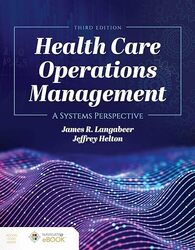
Rating: 7.5/10.
Health Care Operations Management: A Systems Perspective by James R. Langabeer II, Jeffrey Helton
Textbook about healthcare operations, primarily focuses on hospitals in the United States. Several chapters were invaluable, providing specific information about how healthcare works and definitions of commonly used terms in the industry, such as ratios for reasoning about operational efficiency and finances. However, some of the chapters were not too specific to healthcare, like those about strategy planning, project management, introductory statistics, etc, and were therefore less useful.
Chapter 1. Healthcare organizations primarily deliver human services, and they also need to be financially efficient. The job of an operations manager is to make all processes more efficient, improve the productivity and quality of services. Although healthcare can learn from other industries like airline scheduling, it has its own unique challenges. Numerous stakeholders with conflicting interests exist within healthcare organizations and these are often dominated by physicians instead of business leadership. Technology is useful for automating manual processes and provides more visibility into analytics for decision-making.
Chapter 2. Hospitals are typically very large organizations that operate 24 hours a day; there are around 6000 hospitals in the US. Most of these are community hospitals, which provide a wide range of services to the general population. The largest hospitals are teaching hospitals, which, in addition to patient care, also cater to academic and research purposes.
Chapter 3 – Operational Finance: In the US, health care is primarily paid through three ways: Medicare for the elderly, Medicaid for low-income individuals, and commercial insurers, mainly through employment. Additionally, there are uninsured patients who are generally not expected to pay. The three main methods use a reimbursement model with various payment setups, such as reimbursement for service provided versus per day reimbursement or per case. Some systems attempt to reduce population-level health care costs but transfer a lot of risk to the healthcare provider.
The Charge Description Master (CDM) is basically the listing price, and usually a deduction of 30% to 70% is applied; the remainder, minus the deduction, is the amount actually paid. Hospitals generally have an operating margin of 1-3%, and many of them operate at a loss. Hospitals track labor and supply costs per discharge as a measure of efficiency; the Case Mix Index (CMI) is a weighted measure of this based on case complexity. Other financial ratios used to measure efficiency include working capital, which is measured by the number of days of operational expenses needed to have as liquid capital.
Chapter 4: Health Plan Operations. The premium is the amount that the customer pays for the insurance, typically, 80% of the premium should be spent on medical expenses, with the remaining 20% allocated to various administrative expenses and profit. The health plan provides two main products: the first is the benefits paid by the plan, and the second is the network of providers associated with the plan.
The sales team tries to sell the plan to customers: they collect information, give details about insurance plans, and set up enrollment. The network management team negotiates contracts between the insurance company and providers to be included in the network and is responsible for evaluating their credentials. The medical management team works with providers to authorize treatments for patients in order to control costs. Only treatments that are deemed medically necessary are approved, and emergency treatment is automatically authorized.
The claims process comes after the treatment has been provided and allows the insurance to determine how much to pay and what way to reimburse the provider. This can be done in several ways: Diagnosis Related Group (DRG) means reimbursement is based on the diagnosis, but this incentivizes the hospital to provide the minimum level of care. Another method is per day payment, but this could incentivize the facility to keep the patient for a longer stay than necessary. Regardless of the case, a medical review must be conducted to scrutinize the necessity of services.
Chapter 5: Frameworks to analyze strategy, competitive advantage, and financial ROI of potential investments, including formulas to analyze cash flows and future discounted returns on investment.
Chapter 6-7: Processes for improving quality, such as defining metrics, running pilots, benchmarking, etc, and processes aim to measure and reduce defects, minimize waste, and increase overall efficiency.
Chapter 8: A bottleneck is a choke point where the demand is greater than the capacity, it’s important to eliminate any of these bottlenecks as they tend to clog up the entire system. Time series analysis can be used for demand forecasting, but it’s essential to consider the phase of the product: whether it’s in a growth, maturity, or declining phase, these stages have different characteristics, so solely looking at historical data can be misleading.
Capacity planning involves allocating resources to meet the demand; the wait time for patients is an important indicator of whether operational needs are met. A time study is conducted to track how long each step in a procedure takes, observing the mean and variance in this time. Barcodes and RFID technology are useful for automatically tracking patients and medical assets as they move through the system.
Chapter 9: Productivity is a collection of metrics derived from the total of all outputs divided by all inputs. It’s important to account for all of the inputs and outputs, eg, labor as well as supplies. In all cases, factors such as the severity of cases and wages in the area should be accounted for to obtain a more useful metric. Commonly used definitions include Full Time Equivalent (FTE) for labor, which adjusts for aspects like contractors’ vacation time, and Adjusted Occupied Beds (AOB), which encompasses not just patient stays but also tests, therapy, and so forth. Once the metrics have been established, they can be optimized using linear programming to create schedules.
Chapter 10: Project management involves determining the deliverables of a project, managing resources and timelines, and getting buy-in from stakeholders, identifying risks to the critical path, etc.
Chapter 11: Definitions of a bunch of ratios that are commonly used to measure operational efficiency.
Chapter 12: Basic stats and how to calculate them using Excel.
Chapter 13. Data can either be clinical, which deals with medical issues, or administrative, like billing. It can be unstructured, like natural language text, or structured, which is generally easier to work with. Some examples of how to look up normalized database schemas using Excel.
Chapter 14. Operational metrics should be benchmarked either internally, against your historical data or on teams, or through external benchmarking, which involves comparing your ratios with others to determine their effectiveness.
Chapter 15: Supply Chain Management. A supply chain consists of several players, including the manufacturers and the distributor, each of whom holds some level of inventory. Supply chains can be Just in Time (JIT), which is a pull strategy where you purchase items as needed and try not to have too much stockpiled. Alternatively, they can be Supply to Stock (STS), which is a push strategy where you try to order enough of each item and keep it in storage. Reverse logistics involves handling any kind of returns, which go through the supply chain in reverse order and tends to be managed poorly. Supplies typically account for about one-fourth of the total hospital expenditures, but hospitals tend to lag behind in terms of supply chain management technologies.
Chapter 16. Purchasing is often done in competitive bidding: multiple vendors submit an RFP (request for proposal), and a scoresheet is used to select the best based on a variety of different factors, not just the price. It’s important to define performance standards so that the selected party doesn’t just do the minimum as soon as they get the contract. Items in supply have a hierarchy of attributes, with SKU being a specific item at the bottom of the hierarchy. These attributes allow observation managers to analyze many SKUs together in a group.
The three-way match system is a method designed to prevent fraud and corrupt purchases. The rule stipulates that three different people have to purchase the order, then verify the delivery, and finally authorize the payment. This entire process can be done electronically, provided that the three systems handling these actions are all compatible.
Hospitals often group together in a Group Purchasing Organization (GPO) to get bulk discounts, and spending should be measured and analyzed to see if they are being used effectively. HCPCS is a coding system for medical supplies that is often used for reimbursement purposes.
Optimizing the layout of physical resources in a hospital can be done based on mathematical methods that determine how often they need to be used together. Linen management deals with the laundry process, which involves collecting the dirty linens, processing them with commercial washing equipment, and then redistributing them.
Chapter 17. Having inventory in stock protects against variation in demand and is generally more efficient when bought in larger quantities, but it consumes more capital and storage resources when doing so. Accounting when handling inventory needs to attribute the cost to when it is used, not to report a huge loss when buying supplies that will be used in the future. Accounting usually uses the FIFO method to report lower costs: assume items that are first purchased are consumed first, when prices are rising, this leads to overall lower accounting reported costs.
Inventory can be periodic or perpetual. Periodic inventory doesn’t track a running record, but periodically counts how many of each item is available and how many are needed, and then places an order. Perpetual inventory means you keep strict records of inventory, so at each moment in time, you know exactly the count of each item. This is more efficient, but it requires strict tracking of when items are checked out and checked back in.
Shrinkage refers to any loss of inventory due to factors such as expiry, billing areas, etc. This is an expected occurrence, and errors in inventory, other than shrinkage, tend to correct themselves over time; a counterbalancing error is when an error is rectified by itself at a later time. Inventory ratios, such as Economic Order Quantities (EOQ), can be utilized to optimize the number of inventory items to order and stockpile, but for this to be useful, the data must be accurate.
Chapter 18: The Pharmacy. A controlled or scheduled drug carries some degree of harm and can be classified from C-I to C-V, in descending order of risk. Pharmaceutical manufacturers generally have higher margins than both distributors and hospitals.
The NDC (National Drug Code), is a standardized identifier for drugs, it consists of three parts: the company, the product, and the package size. A prescription needs to be delivered from the doctor to the pharmacy, and the items must be picked and packed from the shelf; here, technology has been relatively successful in improving efficiency.



